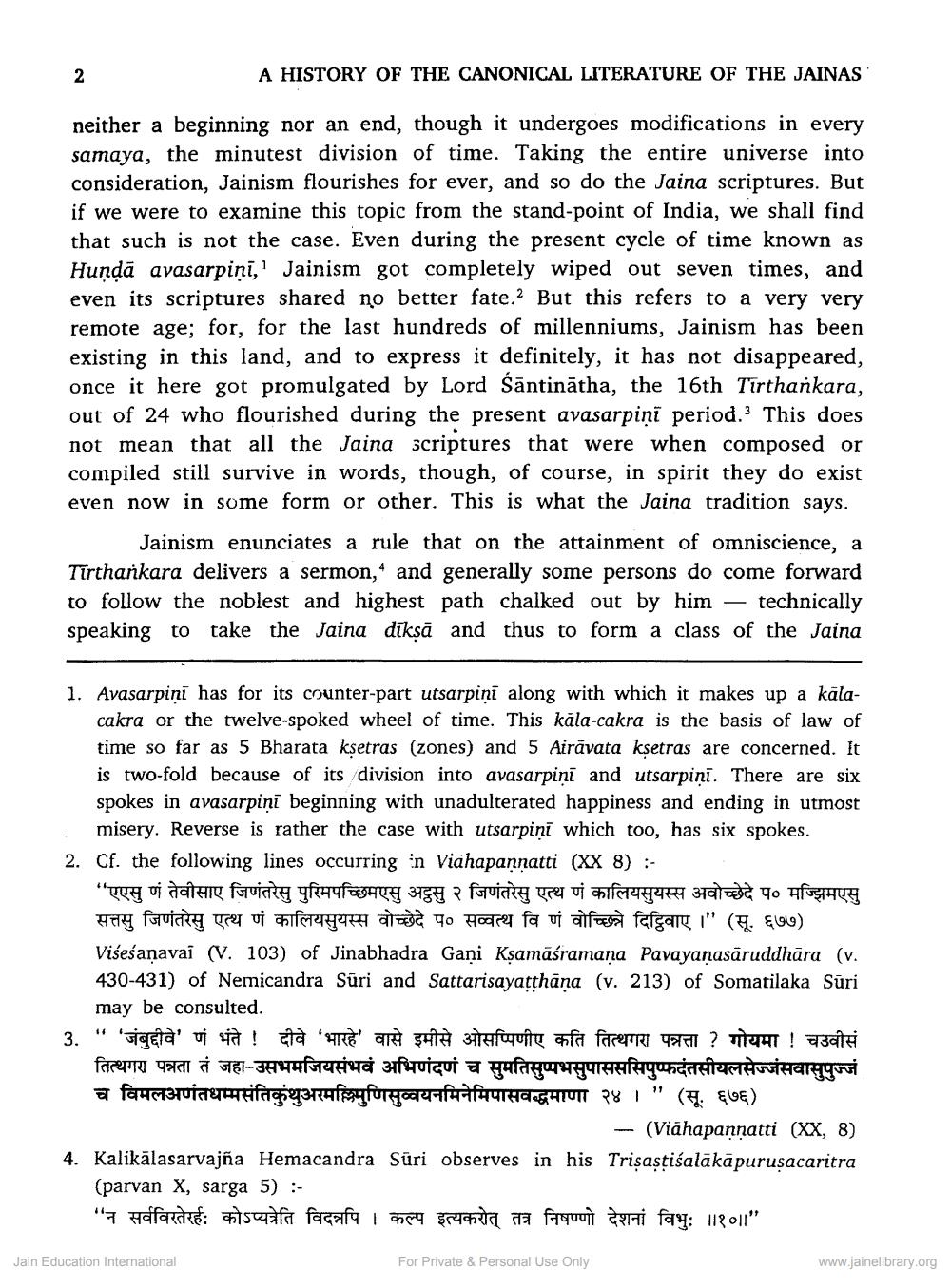________________
A HISTORY OF THE CANONICAL LITERATURE OF THE JAINAS
neither a beginning nor an end, though it undergoes modifications in every samaya, the minutest division of time. Taking the entire universe into consideration, Jainism flourishes for ever, and so do the Jaina scriptures. But if we were to examine this topic from the stand-point of India, we shall find that such is not the case. Even during the present cycle of time known as Hundā avasarpini, Jainism got completely wiped out seven times, and even its scriptures shared no better fate. But this refers to a very very remote age; for, for the last hundreds of millenniums, Jainism has been existing in this land, and to express it definitely, it has not disappeared, once it here got promulgated by Lord Sāntinātha, the 16th Tirthankara, out of 24 who flourished during the present avasarpini period.3 This does not mean that all the Jaina scriptures that were when composed or compiled still survive in words, though, of course, in spirit they do exist even now in some form or other. This is what the Jaina tradition says.
Jainism enunciates a rule that on the attainment of omniscience, a Tirtharkara delivers a sermon, and generally some persons do come forward to follow the noblest and highest path chalked out by him – technically speaking to take the Jaina dīksā and thus to form a class of the Jaina
1. Avasarpini has for its counter-part utsarpini along with which it makes up a kāla
cakra or the twelve-spoked wheel of time. This kāla-cakra is the basis of law of time so far as 5 Bharata kşetras (zones) and 5 Airāvata kşetras are concerned. It is two-fold because of its division into avasarpiņi and utsarpiņi. There are six spokes in avasarpini beginning with unadulterated happiness and ending in utmost
misery. Reverse is rather the case with utsarpiņi which too, has six spokes. 2. Cf. the following lines occurring in Viāhapannatti (XX 8) :
एएसु णं तेवीसाए जिणंतरेसु पुरिमपच्छिमएसु अट्ठसु २ जिणंतरेसु एत्थ णं कालियसुयस्स अवोच्छेदे प० मज्झिमएस सत्तसु जिणंतरेसु एत्थ णं कालियसुयस्स वोच्छेदे प० सव्वत्थ वि णं वोच्छिन्ने दिट्ठिवाए ।" (सू. ६७७) Višeśanavaí (V. 103) of Jinabhadra Gani Kșamāśramana Pavayaņasāruddhāra (v. 430-431) of Nemicandra Sūri and Sattarisayatthāna (v. 213) of Somatilaka Sūri
may be consulted. 3. " 'Field' via ! la 'Free ah sath Tafequitu fa farreri Ya? Tiet! Fathi
तित्थगरा पन्नता तं जहा-उसभमजियसंभवं अभिणंदणं च सुमतिसुप्पभसुपासससिपुष्फदंतसीयलसेज्जंसवासुपुज्ज च विमलअणंतधम्मसंतिकुंथुअरमल्लिमुणिसुव्वयनमिनेमिपासवद्धमाणा २४ । " (सू. ६७६)
- (Viahapannatti (XX, 8) 4. Kalikälasarvajña Hemacandra Suri observes in his Trisastiśalākāpurusacaritra
(parvan X, sarga 5) :"7 Hafan vafa fagafa lang s a a fruunt hi fay: 118011"
Jain Education International
For Private & Personal Use Only
www.jainelibrary.org




